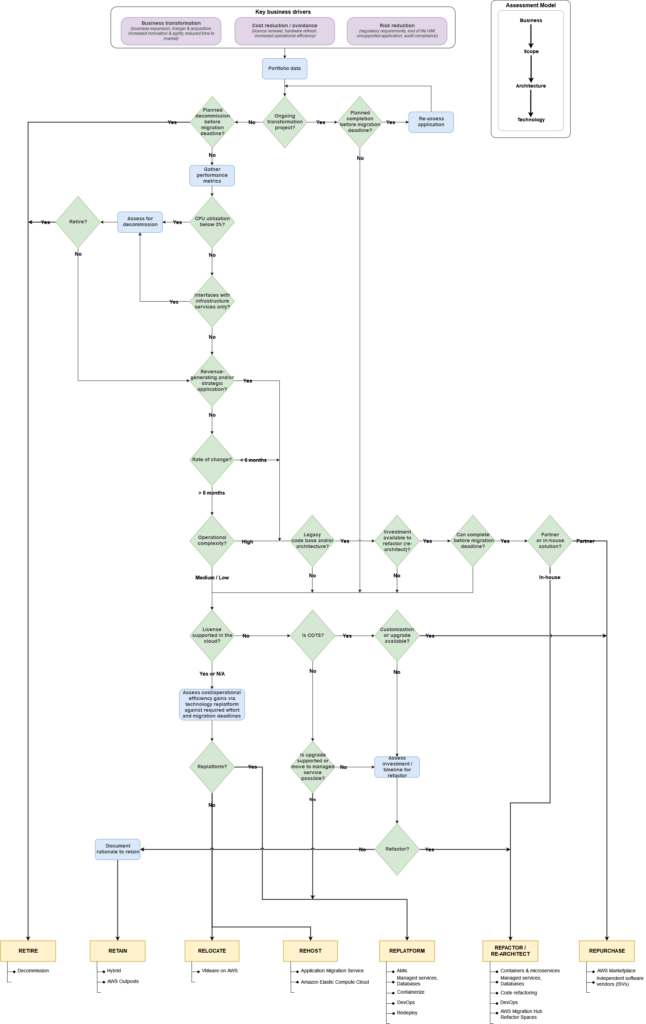Cloud migration is a hot topic for businesses seeking to capitalize on the technological advancements of the 21st century. There are many paths to follow, and picking out the right one is a worthy, if not critical, task.
To help you on our journey, we have produced a three-article series on the 7 Rs of cloud migration: Rehost, Replatform, Relocate, Refactor, Replace/Repurchase, Retire, and Retain.
Our first article explored the evolution of cloud migration 7 R strategies to chart the lessons learned over their evolution. We followed it with a final definition of the 7 Rs, commonly understood today, to create a workable knowledge foundation.
This, the third article, aims to bring it all together and introduce a pathway to making a sound cloud migration strategy choice.
Decision Trees
The first thing one might note about cloud migration strategies is that picking out the best one can be complicated.
Fortunately, Amazon (AWS) provides a handy decision tree to help us figure it out. As you can see, there are lots of decision points to consider. The AWS explainer at the link is worthy of a thorough read if you’re in the planning stages of a cloud migration of any size.
AWS’ recommendation is to consider the underlying parts of an application independently.
AWS Decision Tree for the 7 Rs of Cloud Migration
When to Use Each Migration Model
To simplify things, we’ve created a chart of our own comparing each migration model’s merits, disadvantages, and most appropriate use cases.
Read on to learn more about each strategy and gather insights on ensuring a successful transition to a cloud environment that fulfills your organization’s unique needs and goals.
Rehost
Rehosting, also known as “lift and shift,” involves moving an application from on-premises infrastructure to the cloud without changing its architecture or code.
-
-
- Use Case: This approach is suitable when organizations want to migrate quickly and minimize disruptions to their applications.
- Pros: Quick and simple migration process, minimal disruptions to the application.
- Cons: May miss out on cloud-native features and optimizations.
-
Relocate
Relocating refers to moving an application to a different cloud provider or region within the same cloud provider.
-
-
- Use-case: This approach is useful when there is a need to improve performance, comply with data sovereignty requirements, or leverage specific features offered by another cloud provider.
- Pros: Improved performance, access to unique cloud capabilities, flexibility to choose different cloud providers.
- Cons: Additional costs, potential compatibility challenges with different cloud environments.
-
Replatform
Replatforming involves making minimal modifications to an application’s code or architecture to take advantage of certain cloud services or platform capabilities.
-
-
- Use-case:This approach aims to strike a balance between the simplicity of rehosting and the customization of refactoring.
- Pros: Improved scalability, reduced maintenance efforts, better integration with cloud services.
- Cons: Limitations due to platform constraints, may not fully optimize the application for cloud-native operations.
-
Refactor
Refactoring entails redesigning and modifying an application’s code and architecture to make it more cloud-native, taking full advantage of the cloud environment’s capabilities and services.
-
-
- Use-case: This approach allows for greater optimization, scalability, and flexibility.
- Pros: Cloud-native optimization, improved performance, cost efficiency, greater flexibility.
- Cons: Time-consuming, requires specialized skills, potential need for rewriting significant portions of code.
-
Replace/Repurchase
Replacing or repurchasing involves selecting a new application, either off-the-shelf or as a software-as-a-service (SaaS) solution, to replace the existing one.
-
-
- Use Case: This approach is suitable when the current application is outdated, no longer meets business requirements, or when there are more cost-effective alternatives available.
- Pros: Access to up-to-date features, reduced maintenance efforts, potential cost savings.
- Cons: Data migration challenges, integration complexities, potential disruptions to business operations.
-
Retire
Retiring refers to decommissioning or eliminating applications that are no longer needed or have become obsolete.
-
-
- Use-case: This approach helps reduce maintenance costs, streamline the IT landscape, and eliminate security risks associated with outdated applications.
- Pros: Reduced maintenance costs, streamlined IT landscape, elimination of security risks.
- Cons: Careful decommissioning required to minimize impact on other systems, address data retention and compliance requirements.
-
Retain
Retaining involves keeping an application in its current state, without making any changes or migrating it to the cloud.
-
-
-
- Use-case: This approach is suitable when the application is critical but does not benefit significantly from cloud migration.
-
- Pros: Stability, avoiding disruption, potential deferral of migration costs.
- Cons: Missed opportunities for cloud benefits such as scalability, cost optimization, and improved performance.
Final Thoughts
As you explore and absorb the nuts and bolts of cloud migration, take great care in taking in the best-qualified information you can get your hands on, and be sure to gain exposure to a variety of viewpoints.
Evaluate your specific needs, goals, and constraints when considering the best approach. Consulting with cloud experts and conducting this thorough analysis will help you make an informed decision that aligns with your organization’s overall strategy.
We also strongly recommend assessing your application with software tools to get a detailed snapshot of the application you are migrating (more on that below).
And remember to think about potential post-migration tasks such as ongoing maintenance, monitoring, and optimization to ensure long-term success in your new cloud environment.
Happy Migrating!
Pick the Right Migration Strategy with CM evolveIT
CM evolveIT provides a comprehensive suite of tools and services designed to help you assess your legacy application and help you pick the migration strategy most likely to achieve your company’s objectives.
The tool’s granular approach to modernization is designed to help you get the process underway with minimal disruption to your existing operations. You’ll be able to extract and re-engineer individual components before taking the final critical modernization step.
When your modernization effort is finally underway, CM evolveIT will assist with a suite of tools and services designed to automate the migration process, including code analysis and transformation tools that help you understand the structure of your legacy code and identify areas for improvement.
Contact CM First today to learn more about how our CM evolveIT software can help you modernize your systems, reduce costs, and improve efficiency.
-
-




